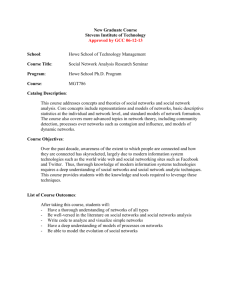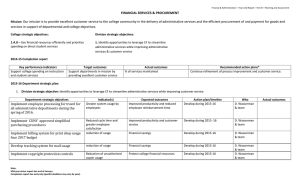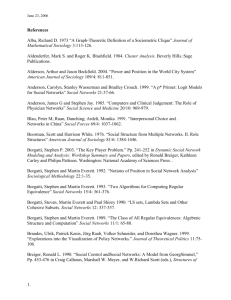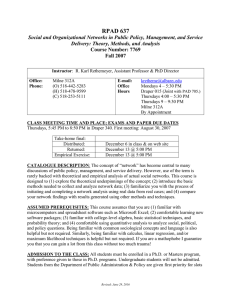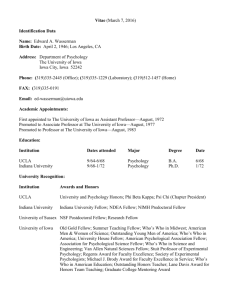Social Network Analysis: An Introduction
advertisement
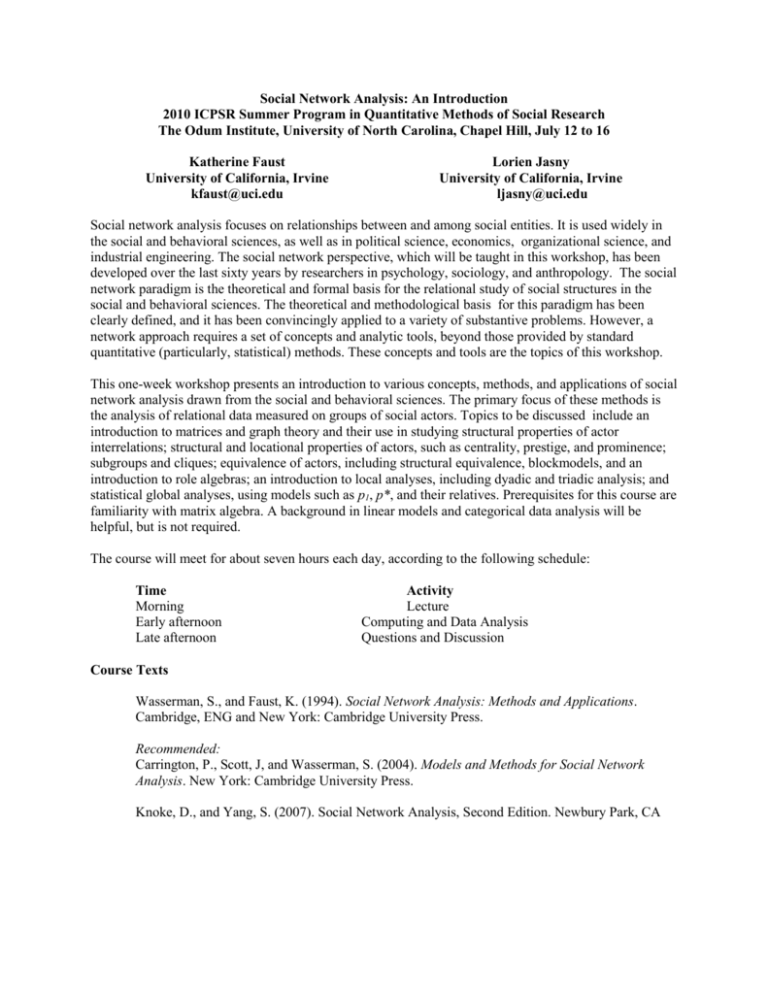
Social Network Analysis: An Introduction 2010 ICPSR Summer Program in Quantitative Methods of Social Research The Odum Institute, University of North Carolina, Chapel Hill, July 12 to 16 Katherine Faust University of California, Irvine kfaust@uci.edu Lorien Jasny University of California, Irvine ljasny@uci.edu Social network analysis focuses on relationships between and among social entities. It is used widely in the social and behavioral sciences, as well as in political science, economics, organizational science, and industrial engineering. The social network perspective, which will be taught in this workshop, has been developed over the last sixty years by researchers in psychology, sociology, and anthropology. The social network paradigm is the theoretical and formal basis for the relational study of social structures in the social and behavioral sciences. The theoretical and methodological basis for this paradigm has been clearly defined, and it has been convincingly applied to a variety of substantive problems. However, a network approach requires a set of concepts and analytic tools, beyond those provided by standard quantitative (particularly, statistical) methods. These concepts and tools are the topics of this workshop. This one-week workshop presents an introduction to various concepts, methods, and applications of social network analysis drawn from the social and behavioral sciences. The primary focus of these methods is the analysis of relational data measured on groups of social actors. Topics to be discussed include an introduction to matrices and graph theory and their use in studying structural properties of actor interrelations; structural and locational properties of actors, such as centrality, prestige, and prominence; subgroups and cliques; equivalence of actors, including structural equivalence, blockmodels, and an introduction to role algebras; an introduction to local analyses, including dyadic and triadic analysis; and statistical global analyses, using models such as p1, p*, and their relatives. Prerequisites for this course are familiarity with matrix algebra. A background in linear models and categorical data analysis will be helpful, but is not required. The course will meet for about seven hours each day, according to the following schedule: Time Morning Early afternoon Late afternoon Activity Lecture Computing and Data Analysis Questions and Discussion Course Texts Wasserman, S., and Faust, K. (1994). Social Network Analysis: Methods and Applications. Cambridge, ENG and New York: Cambridge University Press. Recommended: Carrington, P., Scott, J, and Wasserman, S. (2004). Models and Methods for Social Network Analysis. New York: Cambridge University Press. Knoke, D., and Yang, S. (2007). Social Network Analysis, Second Edition. Newbury Park, CA Topics Topics to be taught and the relevant chapters from Wasserman and Faust are: Chapter 1: Introduction Chapter 2: Social Network Data: Collection and Applications Chapter 3: Notation for Social Network Data Chapter 4: Graphs and Matrices Chapter 5: Centrality, Prestige, Prominence, and Related Concepts Chapter 7: Cohesive Subgroups Chapter 9: Structural Equivalence Chapter 10: Blockmodels Chapter 13: Dyads Chapter 15: Statistical Analysis of Single Relational Networks Computer Programs We will be using a number of different social network analysis computer programs. UCINET from Analytic Technologies. A trial version is available for free. http://www.analytictech.com/archive/ucinet.htm NETDRAW from Analytic Technologies, comes with UCINET or separately from http://www.analytictech.com/Netdraw/netdraw.htm Pajek at: http://pajek.imfm.si/doku.php?id=download StOCNET from http://stat.gamma.rug.nl/stocnet/ Other Resources These are some especially useful resources on social networks. The International Network for Social Network Analysis (INSNA) is the international and interdisciplinary professional association for people interested in social network research. Its website (http://www.insna.org/ ) is a useful source of information and resources on social networks, including links to many informative sites and to social network computer programs and data. The listserv, SOCNET, is the main on-line forum for discussion of current topics on social networks. Information on how to join is available through the INSNA site Connections is INSNA’s newsletter/ informal journal. It is available through the INSNA website or directly at: http://www.insna.org/pubs/connections/ Journal of Social Structure is an online journal with many articles of interest to social network researchers. http://www.cmu.edu/joss/index.html Steve Borgatti’s web page is a good source of introductory material and handouts on various topics on social networks. http://www.analytictech.com/networks/ Robert Hanneman and Mark Riddle’s 2005 one line textbook Introduction to Social Network Methods http://faculty.ucr.edu/~hanneman/nettext/ includes many illustrations using UCINET. Data examples from Wasserman and Faust are available at the INSNA website. http://www.insna.org/software/public_data.html Further Readings 1: Introduction to Social Networks and Network Applications Wasserman and Faust, Chapters 1 and 2 Butts, Carter T. 2008 “Social network analysis: A methodological introduction” Asian Journal of Social Psychology 11(1) : 13-41. Hawe, Penelope, Cynthia Webster and Alan Shiell 2004 “A glossary of terms for navigating the field of social network analysis” J Epidemiol Community Health 58: 971-975 Wellman, Barry 1988. “Structural analysis: From method and metaphor to theory and substance.” Pages 19-61 in Wellman and Berkowitz (eds.) Social Structures: A Network Approach. Cambridge: Cambridge University Press. Marsden, Peter. 2004. “Network Analysis.” Pp. 819-825 in Kimberly Kempf-Leonard (ed.) Encyclopedia of Social Measurement. San Diego, CA: Academic Press, 2: Representing Networks: Graphs, Matrices, and Network Visualization Wasserman and Faust, Chapters 3 and 4 Freeman, Linton “Visualizing Social Networks” Journal of Social Structure, available at: http://www.cmu.edu/joss/content/articles/volume1/Freeman.html Freeman, Linton 2005. “Graphic techniques for exploring social network data.” Chapter 12, pages 248-269 in Carrington, Peter J., John Scott, and Stanley Wasserman (eds.) Models and Methods in Social Network Analysis. Cambridge: Cambridge University Press. McGrath, Cathleen, Jim Blythe, and David Krackhardt “Seeing Groups in Graph Layouts” available at http://www.andrew.cmu.edu/user/cm3t/groups.html 3: Graph Theory for Network Analysis Wasserman and Faust, Chapter 4 Borgatti, Stephen 1994 “A quorum of graph theoretic concepts.” Connections 17:47-49. 4: Centrality and Centralization Wasserman and Faust, Chapter 5 Freeman, Linton 1979. “Centrality in social networks: Conceptual clarification.” Social Networks 1:215-239. Friedkin, Noah 1991. “Theoretical Foundations for Centrality Measures.” American Journal of Sociology, 96(6):1478-1504. 5: Cohesive Subgroups and Two Mode Networks Wasserman and Faust, Chapters 7 and 8 Erickson, Bonnie. 1988. “The relational basis of attitudes.” Pages 99-121 in Barry Wellman and Stephen Berkowitz (eds.) Social Structures: A Network Approach. Cambridge: Cambridge University Press. Freeman, Linton 1992 “The sociological concept of group: An empirical test of two models.” American Journal of Sociology. 98(1):152-166. Breiger, Ronald. 1974. “The duality of persons and groups.” Social Forces. 53:191-190. Moody, James and Douglas R. White. 2003. “Structural Cohesion and Embeddedness: A hierarchical conception of Social Groups.” American Sociological Review 68:103-127 6: Equivalences and Blockmodels, Network Roles and Algebraic Models Wasserman and Faust, Chapter 9, 10, and 11 Lorrain, Francois and Harrison White. 1971. “Structural equivalence of individuals in social networks. Mathematical Sociology 1:49-80. White, Harrison, Scott Boorman and Ronald Breiger. 1976. “Social structure from multiple networks: I. Blockmodels of roles and positions.” American Journal of Sociology 81(4):730-780. Borgatti, Steve and Martin Everett 1992. “Notions of position in network analysis.” Sociological Methodology 22:1-36. Doreian, Patrick, Vladimir Batagelj, and Anuska Ferligoj 2005. “Positioanl analyses of sociometric data.” Chapter 5 pages 77-97 in Carrington, Peter J., John Scott, and Stanley Wasserman (eds.) Models and Methods in Social Network Analysis. Cambridge: Cambridge University Press. 7: Subgraphs: Dyads, and Triads Wasserman and Faust, Chapters 6, 13 and 14 Holland, Paul, and Samuel Leinhardt 1971. “Transitivity in structural models of small groups.” Comparative Group Studies 2:107-124. Cartwright, D. and Frank Harary. 1979. Balance and clusterability: An overview. In Holland, P.W. and Leinhardt, S. (eds.), Perspectives on Social Network Research, pages 25-50. New York: Academic Press. Davis, James. 1967. “Clustering and structural balance in graphs.” Human Relations. 20:181187. 8: Multiple Relations, Testing Hypotheses about Social Networks Hubert, L. 1978. “Evaluating the conformity of sociometric measurements.” Psychometrika 43:31-41. 9: Statistical Models Wasserman and Faust, Chapter 15 Anderson, C. J., Wasserman, S., and Crouch, B. (1999), "A p* Primer: Logit Models for Social Networks," Social Networks, 21, pp. 37-66. Wasserman, Stanley and Garry Robins 2005. “An introduction to random graphs, dependence graphs, and p*” Chapter 8 pages 148-161 in Carrington, Peter J., John Scott, and Stanley Wasserman (eds.) Models and Methods in Social Network Analysis. Cambridge: Cambridge University Press.
